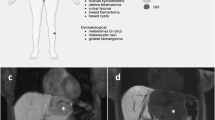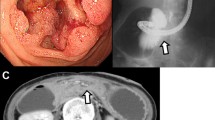Abstract
Muir Torre syndrome is a rare autosomal dominant cancer-predisposing syndrome characterized by the occurrence of sebaceous gland neoplasms and/or keratoacanthomas associated with visceral malignancies that belong to the spectrum of hereditary non polyposis colorectal cancer (HNPCC), i.e., tumors of gastrointestinal and genitourinary tracts. Hepatobiliary malignancy in association with Muir Torre syndrome has rarely been reported. Here, we describe a case of Muir Torre syndrome associated with an hepatocellular-carcinoma in a patient with a non-cirrhotic liver and an HNPCC-family with multiple cases of hepatocellular carcinoma.





Similar content being viewed by others
Abbreviations
- MTS:
-
Muir-Torre syndrome
- HNPCC:
-
Hereditary non polyposis colorectal cancer
- HCC:
-
Hepatocellular carcinoma
- FNAB:
-
Fine needle aspiration biopsy
- HOMA:
-
Homeostasis model assessment
- NAFLD:
-
Non alcoholic fatty liver disease
References
Muir EG, Bell AJ, Barlow KA (1967) Multiple primary carcinomata of the colon, duodenum, and larynx associated with kerato-acanthomata of the face. Br J Surg 54:191–195
Torre D (1968) Multiple sebaceous tumours. Arch Dermatol 98:549–551
Schwartz RA, Torre DP (1995) The Muir-Torre syndrome: a 25-year retrospect. J Am Acad Dermatol 33:90–104
Ponti G, de Ponz Leon M, Maffei S et al (2005) Attenuated familial adenomatous polyposis and Muir-Torre syndrome linked to compound biallelic constitutional MYH gene mutations. Clin Genet 68:442–447
Honchel R, Halling KC, Schaid DJ et al (1994) Microsatellite instability in Muir-Torre syndrome. Cancer Res 54:1159–1163
Lynch HT, de la Chapelle A (2003) Genomic medicina: hereditary colorectal cancer. N Engl J Med 348:919–932
Lazar AJ, Lyle S, Calonje E (2007) Sebaceous neoplasia and Torre-Muir syndrome. Curr Diagn Pathol 13:301–319
Vernez M, Hutter P, Monnerat C et al (2007) A case of Muir-Torre syndrome associated with mucinous hepatic cholangiocarcinoma and a novel germline mutation of the MSH2 gene. Fam Cancer 6:141–145
Akhtar S, Oza KK, Khan SA et al (1999) Muir-Torre syndrome: case report of a patient with concurrent jejunal and ureteral cancer and a review of the literature. J Am Acad Dermatol 41:681–686
Chhibber V, Dresser K, Mahalingam M (2008) MSH-6: extending the reliability of immunohistochemistry as a screening tool in Muir-Torre syndrome. Mod Pathol 21:159–164
Vasen HF, Watson P, Mecklin JP et al (1999) New clinical criteria for hereditary nonpolyposis colorectal cancer (HNPCC, Lynch syndrome) proposed by the international collaborative group on HNPCC. Gastroenterology 116:1453–1456
Bellentani S, Saccoccio G, Costa G et al (1997) Drinking habits as cofactors of risk for alcohol induced liver damage. The dionysos study group. Gut 41:845–850
Barrow E, Robinson L, Alduaij W et al (2009) Cumulative lifetime incidence of extracolonic cancers in Lynch syndrome: a report of 121 families with proven mutations. Clin Genet 75:141–149
Zhang YZ, Sheng J-Q, Li S-R et al (2005) Clinical phenotype and prevalence of hereditary nonpolyposis colorectal cancer syndrome in Chinese population. World J Gastroenterol 11:1481–1488
Takagi K, Esumi M, Takano S et al (1998) Replication error frequencies in primary hepatocellular carcinoma: a comparison of solitary primary versus multiple primary cancers. Liver 18:272–276
Salvucci M, Lemoine A, Saffroy R et al (1999) Microsatellite instability in European hepatocellular carcinoma. Oncogene 18:181–187
Chiappini F, Gross-Goupil M, Saffroy R et al (2004) Microsatellite instability mutator phenotype in hepatocellular carcinoma in non-alcoholic and non-virally infected normal livers. Carcinogenesis 25:541–547
Han HJ, Yanagisawa A, Kato Y et al (1993) Genetic instability in pancreatic cancer and poorly differentiated type of gastric cancer. Cancer Res 53:5087–5089
Saeki A, Tamura S, Ito N et al (2000) Lack of frameshift mutations at coding mononucleotide repeats in hepatocellular carcinoma in Japanese patients. Cancer 88:1025–1029
Wang L, Bani-Hani A, Montoya DP et al (2001) hMLH1 and hMSH2 expression in human hepatocellular carcinoma. Int J Oncol 19:567–570
Togni R, Bagla N, Muiesan P et al (2009) Microsatellite instability in hepatocellular carcinoma in non-cirrhotic liver in patients older than 60 years. Hepatol Res 39:226–273
Dores GM, Curtis RE, Toro JR et al (2008) Incidence of cutaneous sebaceous carcinoma and risk of associated neoplasms: insight into Muir-Torre syndrome. Cancer 113:3372–3381
Fattovich G, Stroffolini T, Zagni I et al (2004) Hepatocellular carcinoma in cirrhosis: incidence and risk factors. Gastroenterology 127:S35–S50
Cohen PR, Kohn SR, Kurzrock R (1991) Association of sebaceous gland tumors and internal malignancy: the Muir-Torre syndrome. Am J Med 90:606–613
Stella A, Surdo NC, Lastella P et al (2007) Germline novel MSH2 deletions and a founder MSH2 deletion associated with anticipation effects in HNPCC. Clin Genet 71:130–139
Colon cancer gene variant databases© 2004–2011 Leiden University Medical Center. (http://chromium.liacs.nl/LOVD2/colon_cancer/home.php)
Thiffault I, Hamel N, Pal T et al (2004) Germline truncating mutations in both MSH2 and BRCA2 in a single kindred. Br J Cancer 90:483–491
Stucklessr S, Parfrey PS, Woods MO et al (2007) The phenotypic expression of 3 MSH2 mutations in large newfoundland families with Lynch syndrome. Fam Cancer 6:1–12
Levi Z, Hazai R, Kedar-Barnes I et al (2007) Switching from tacrolimus to sirolimus halts the appearance of new sebaceous neoplasms in Muir-Torre syndrome. Am J Transpl 7:476–479
Sethi A, Straviz RT (2007) Review article: medical management of the liver transplant recipient: a primer for non-transplant doctors. Aliment Pharmacol Ther 25:229–245
Author information
Authors and Affiliations
Corresponding author
Rights and permissions
About this article
Cite this article
Morando, F., Alaibac, M., Romano, A. et al. The liver: another organ involved in Muir Torre syndrome?. Familial Cancer 11, 7–12 (2012). https://doi.org/10.1007/s10689-011-9450-1
Published:
Issue Date:
DOI: https://doi.org/10.1007/s10689-011-9450-1




